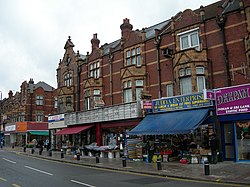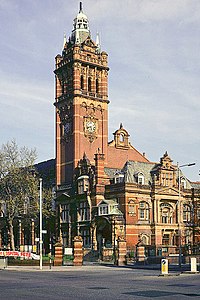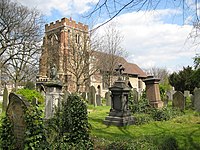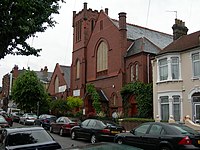East Ham: Difference between revisions
No edit summary |
|||
| Line 13: | Line 13: | ||
|constituency=East Ham | |constituency=East Ham | ||
}} | }} | ||
'''East Ham''' is a suburban town in [[Essex]], wholly within the metropolitan conurbation. It is a built-up district to the east of its near namesake, [[West Ham]]. East Ham and West Ham have a common origin but separated in the Middle Ages. Both are in the | '''East Ham''' is a suburban town in [[Essex]], wholly within the metropolitan conurbation. It is a built-up district to the east of its near namesake, [[West Ham]]. East Ham and West Ham have a common origin but separated in the Middle Ages. Both are in the [[Becontee Hundred]] of Essex. | ||
East Ham is identified in the Greater London Authority's "London Plan" as one of 35 major centres in its area.<ref name=london_plan_f08>{{cite web|url=http://www.london.gov.uk/thelondonplan/docs/londonplan08.pdf | author=Mayor of London | publisher=Greater London Authority | title=London Plan (Consolidated with Alterations since 2004) | month=February | year=2008 }}</ref> | East Ham is identified in the Greater London Authority's "London Plan" as one of 35 major centres in its area.<ref name=london_plan_f08>{{cite web|url=http://www.london.gov.uk/thelondonplan/docs/londonplan08.pdf | author=Mayor of London | publisher=Greater London Authority | title=London Plan (Consolidated with Alterations since 2004) | month=February | year=2008 }}</ref> | ||
The principal offices of the local council were untl 2009 located at the junction of Barking Road and High Street South in the former East Ham Town Hall, a grand Grade II listed Edwardian structure designed by A. H. Campbell, H. Cheers and J. Smith, and including a landmark clock tower. Built between 1901 and 1903, the Town Hall was opened by Passmore Edwards on 5 February 1903.<ref>[http://pmsa.cch.kcl.ac.uk/UEL/NE048.htm Public Monument and Sculpture Association] Accessed 1 Apr 2007</ref> The council moved to "Newham Dockside" in 2009. | The principal offices of the local council were untl 2009 located at the junction of Barking Road and High Street South in the former East Ham Town Hall, a grand Grade-II-listed Edwardian structure designed by A. H. Campbell, H. Cheers and J. Smith, and including a landmark clock tower. Built between 1901 and 1903, the Town Hall was opened by Passmore Edwards on 5 February 1903.<ref>[http://pmsa.cch.kcl.ac.uk/UEL/NE048.htm Public Monument and Sculpture Association] Accessed 1 Apr 2007</ref> The council moved to "Newham Dockside" in 2009. | ||
==History== | ==History== | ||
| Line 42: | Line 42: | ||
===Other religions=== | ===Other religions=== | ||
Due to the significant minority of South Indians, Tamils, there are two | Due to the significant minority of South Indians, Tamils, there are two Hindu temples in the area, dedictated to titular deities of the Hindu religion. One of the temples was recently rebuilt with a larger prayer hall and traditional temple tower as is typical of Tamil temples in India and Ceylon. | ||
Due to a very large Muslim community, East Ham also has many mosques. East Ham is a very multicultural area. | Due to a very large Muslim community, East Ham also has many mosques. East Ham is a very multicultural area. | ||
Revision as of 18:46, 19 December 2018
| East Ham | |
| Essex | |
|---|---|
 High Street North | |
| Location | |
| Grid reference: | TQ425835 |
| Location: | 51°31’56"N, -0°3’19"E |
| Data | |
| Post town: | London |
| Postcode: | E6 |
| Dialling code: | 020 |
| Local Government | |
| Council: | Newham |
| Parliamentary constituency: |
East Ham |
East Ham is a suburban town in Essex, wholly within the metropolitan conurbation. It is a built-up district to the east of its near namesake, West Ham. East Ham and West Ham have a common origin but separated in the Middle Ages. Both are in the Becontee Hundred of Essex.
East Ham is identified in the Greater London Authority's "London Plan" as one of 35 major centres in its area.[1]
The principal offices of the local council were untl 2009 located at the junction of Barking Road and High Street South in the former East Ham Town Hall, a grand Grade-II-listed Edwardian structure designed by A. H. Campbell, H. Cheers and J. Smith, and including a landmark clock tower. Built between 1901 and 1903, the Town Hall was opened by Passmore Edwards on 5 February 1903.[2] The council moved to "Newham Dockside" in 2009.
History

Foundation and name
A settlement in the area named Ham is first recorded as Hamme in an Anglo-Saxon charter of 958 and then in the 1086 Domesday Book as Hame. It is formed from Old English 'hamm' and means 'a dry area of land between rivers or marshland', referring the location of the settlement within boundaries formed by the rivers Lea, Thames and Roding and their marshes.[3]
Economic development
In 1859 East Ham railway station opened and, although in 1863 the area was still being described as a "scattered village" the availability of transport resulted in increasing urbanisation, especially from 1890 onwards.[4] The electric services of the District Railway first served East Ham in 1908.[5]
Geography
Housing in East Ham consists principally of Victorian and Edwardian terraced town houses, often in tree-lined avenues, which radiate from the High Street. West Ham United FC's ground is located on the western border of East Ham and the eastern border of Upton Park, in the so-called Tudor district of the town.
There are many green spaces in the otherwise bustling and urbanised area of East Ham. The graveyard of the Norman St Mary's Church, is maintained as a nature reserve, the largest of its kind in the metropolis.
Central Park (Central Park Road) and Plashet Park (Plashet Grove) are the two largest parks in East Ham, and both combine open space with playgrounds and cafés. There are also smaller play areas and parks, including Priory Park (Grangewood Street) and Flanders Field, where England football captain Bobby Moore played as a child during the late 1940s and early 1950s. Flanders Fields is currently the home ground of Flanders FC and other is used by Bonny Downs Community Assiciation (BDCA) and other community groups.
Churches


There are numerous places of worship for many different religions, ranging from St Michael's Church to Kensington Avenue Temple.
The Parish Church of St Mary Magdalene dates to the first half of the 12th century and is claimed to be the oldest parish church still in use in the metropolis.[6] It contains a memorial to an Edmond Nevill, who laid claim to the attainted title of Earl of Westmoreland in the 17th century.
Other religions
Due to the significant minority of South Indians, Tamils, there are two Hindu temples in the area, dedictated to titular deities of the Hindu religion. One of the temples was recently rebuilt with a larger prayer hall and traditional temple tower as is typical of Tamil temples in India and Ceylon.
Due to a very large Muslim community, East Ham also has many mosques. East Ham is a very multicultural area.
People
East Ham is a multi-cultural area, in which native White Britons are a minority, compared with a population of South Asians, Africans/Caribbeans and eastern Europeans.
As of 2010, East Ham has the fourth highest level of unemployment in Britain, with 16.5% of its residents registered unemployed. Around 7 in 10 children living in East Ham are from low income families, making it one of the worst areas in the country for child poverty. [7]
Economy
There are many stores and restaurants specialising in ethnic tastes. There are also still traditional East End eateries. The century-old Robin's, which specialised in the traditional East End dish of pie, mash and jellied eels has now closed for good.
Transport and nearby towns
Mass transport is provided by East Ham tube station and bus services which form a hub near the Town Hall. To the north of East Ham is Manor Park and Little Ilford, to the east over the A406 North Circular Road is Barking, to the west is Upton Park and to the south over the A13 is Beckton and London City Airport.
Sport
The local football club, East Ham United was dissolved in 2001 when it merged into Barking & East Ham United. The merged club was in turn dissolved in 2006. The claret and blue of West Ham FC are seen displayed in shops in East Ham today.
See also
References
- ↑ Mayor of London (February 2008). "London Plan (Consolidated with Alterations since 2004)". Greater London Authority. http://www.london.gov.uk/thelondonplan/docs/londonplan08.pdf.
- ↑ Public Monument and Sculpture Association Accessed 1 Apr 2007
- ↑ Mills, A.D. (2001). Dictionary of London Place Names. Oxford.
- ↑ 'Becontree hundred: East Ham', A History of the County of Essex: Volume 6 (1973), pp. 1-8 accessed: 26 April 2007.
- ↑ Rose, D., The London Underground: A diagrammatic history, (1999)
- ↑ 'East Ham: Churches', A History of the County of Essex: Volume 6 (1973), pp. 25-31 accessed: 26 April 2007.
- ↑ Unemployment blackspots, from Virgin Media